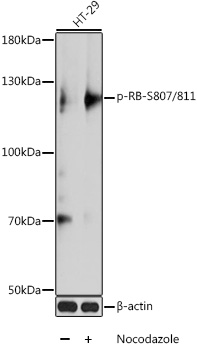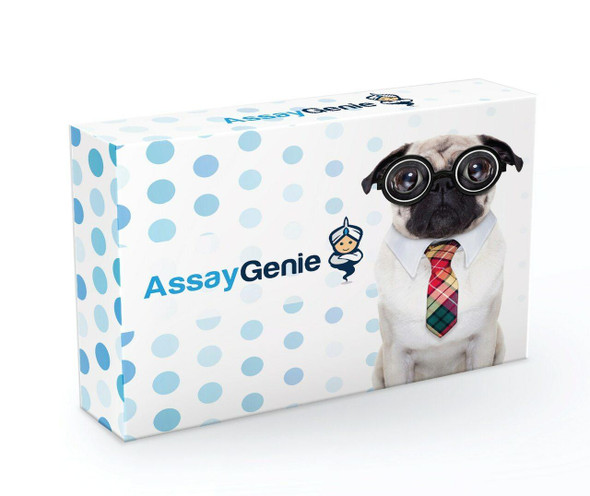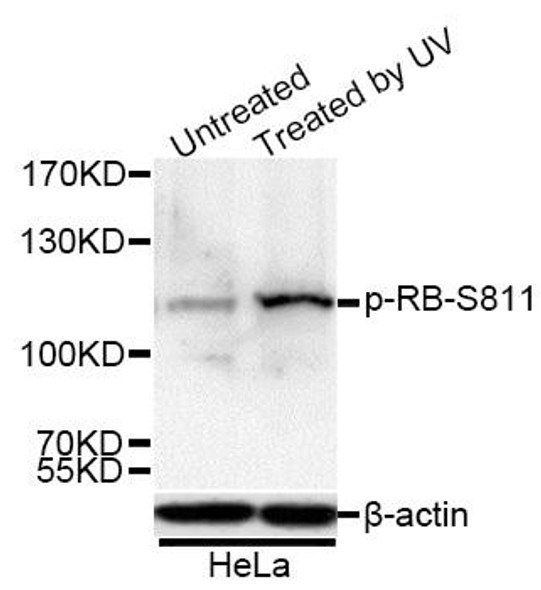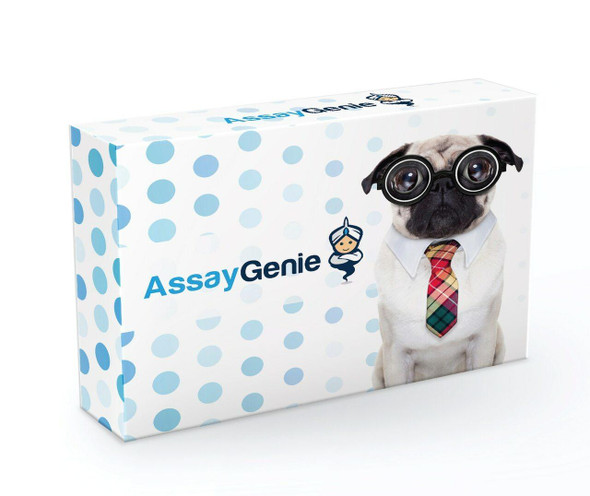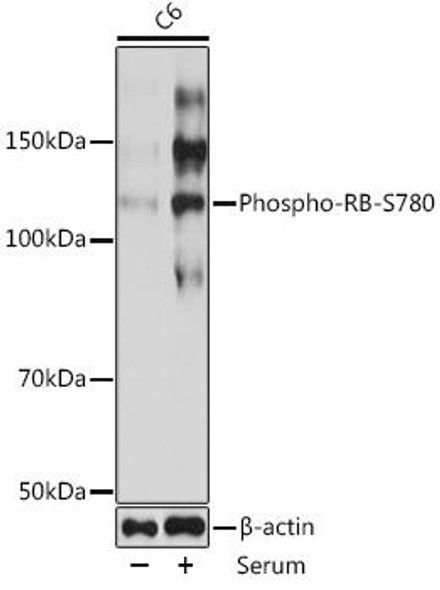Cell Cycle Antibodies 2
Anti-Phospho-Rb-S807/811 Antibody (CABP0484)
- SKU:
- CABP0484
- Product Type:
- Antibody
- Applications:
- WB
- Reactivity:
- Human
- Host Species:
- Rabbit
- Isotype:
- IgG
- Research Area:
- Cell Cycle
Description
| Antibody Name: | Anti-Phospho-Rb-S807/811 Antibody |
| Antibody SKU: | CABP0484 |
| Antibody Size: | 20uL, 50uL, 100uL |
| Application: | WB |
| Reactivity: | Human, Mouse, Rat |
| Host Species: | Rabbit |
| Immunogen: | A synthetic phosphorylated peptide around S807 & S811 of human RB (NP_000312.2). |
| Application: | WB |
| Recommended Dilution: | WB 1:500 - 1:2000 |
| Reactivity: | Human, Mouse, Rat |
| Positive Samples: | HT-29 |
| Immunogen: | A synthetic phosphorylated peptide around S807 & S811 of human RB (NP_000312.2). |
| Purification Method: | Affinity purification |
| Storage Buffer: | Store at -20°C. Avoid freeze / thaw cycles. Buffer: PBS with 0.02% sodium azide, 50% glycerol, pH7.3. |
| Isotype: | IgG |
| Sequence: | SPLK S |
| Gene ID: | 5925 |
| Uniprot: | P06400 |
| Cellular Location: | Nucleus |
| Calculated MW: | 106kDa |
| Observed MW: | 120kDa |
| Synonyms: | OSRC, PPP1R130, RB, p105-Rb, pRb, pp110, RB1, Rb |
| Background: | The protein encoded by this gene is a negative regulator of the cell cycle and was the first tumor suppressor gene found. The encoded protein also stabilizes constitutive heterochromatin to maintain the overall chromatin structure. The active, hypophosphorylated form of the protein binds transcription factor E2F1. Defects in this gene are a cause of childhood cancer retinoblastoma (RB), bladder cancer, and osteogenic sarcoma. |
| UniProt Protein Function: | Rb: retinoblastoma tumor suppressor protein regulates cell proliferation by controlling progression through the G1-phase restriction point. Has three distinct binding domains and interacts with regulatory proteins including the E2F family of transcription factors, c-Abl tyrosine kinase and proteins with a conserved LXCXE motif. Cell cycle-dependent phosphorylation by Cdks inhibits Rb target binding, thus allowing cell cycle progression. Recruits and targets histone methyltransferase suv39h1 leading to epigenetic transcriptional repression. |
| UniProt Protein Details: | Protein type:Oncoprotein; Transcription, coactivator/corepressor; Nuclear receptor co-regulator; Tumor suppressor Chromosomal Location of Human Ortholog: 13q14.2 Cellular Component: nucleoplasm; SWI/SNF complex; PML body; Rb-E2F complex; spindle; chromatin; nucleus Molecular Function:identical protein binding; protein binding; androgen receptor binding; DNA binding; ubiquitin protein ligase binding; transcription coactivator activity; phosphoprotein binding; transcription factor binding; kinase binding; transcription factor activity Biological Process: sister chromatid biorientation; viral reproduction; positive regulation of transcription, DNA-dependent; negative regulation of transcription from RNA polymerase II promoter, mitotic; regulation of mitotic cell cycle; neuron maturation; positive regulation of macrophage differentiation; cell cycle arrest; neurite development; negative regulation of epithelial cell proliferation; transcription, DNA-dependent; negative regulation of transcription factor activity; mitotic cell cycle checkpoint; enucleate erythrocyte differentiation; regulation of lipid kinase activity; chromatin remodeling; G1/S-specific transcription in mitotic cell cycle; myoblast differentiation; neuron apoptosis; maintenance of mitotic sister chromatid cohesion; gut development; cell division; neuron morphogenesis during differentiation; negative regulation of smoothened signaling pathway; androgen receptor signaling pathway; Ras protein signal transduction; positive regulation of mitotic metaphase/anaphase transition; negative regulation of protein kinase activity; striated muscle cell differentiation; positive regulation of transcription from RNA polymerase II promoter; mitotic cell cycle; negative regulation of transcription, DNA-dependent; cell cycle checkpoint; G1/S transition of mitotic cell cycle Disease: Bladder Cancer; Osteogenic Sarcoma; Small Cell Cancer Of The Lung; Retinoblastoma |
| NCBI Summary: | The protein encoded by this gene is a negative regulator of the cell cycle and was the first tumor suppressor gene found. The encoded protein also stabilizes constitutive heterochromatin to maintain the overall chromatin structure. The active, hypophosphorylated form of the protein binds transcription factor E2F1. Defects in this gene are a cause of childhood cancer retinoblastoma (RB), bladder cancer, and osteogenic sarcoma. [provided by RefSeq, Jul 2008] |
| UniProt Code: | P06400 |
| NCBI GenInfo Identifier: | 132164 |
| NCBI Gene ID: | 5925 |
| NCBI Accession: | P06400.2 |
| UniProt Secondary Accession: | P06400,P78499, Q5VW46, Q8IZL4, A8K5E3, |
| UniProt Related Accession: | P06400 |
| Molecular Weight: | 928 |
| NCBI Full Name: | Retinoblastoma-associated protein |
| NCBI Synonym Full Names: | retinoblastoma 1 |
| NCBI Official Symbol: | RB1 |
| NCBI Official Synonym Symbols: | RB; pRb; OSRC; pp110; p105-Rb; PPP1R130 |
| NCBI Protein Information: | retinoblastoma-associated protein; retinoblastoma suspectibility protein; prepro-retinoblastoma-associated protein; protein phosphatase 1, regulatory subunit 130 |
| UniProt Protein Name: | Retinoblastoma-associated protein |
| UniProt Synonym Protein Names: | p105-Rb; pRb; Rb; pp110 |
| Protein Family: | Retinoblastoma-associated protein |
| UniProt Gene Name: | RB1 |
| UniProt Entry Name: | RB_HUMAN |


